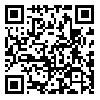

Volume 5, Issue 15 (Winter 2022)
J Altern Vet Med 2022, 5(15): 906-916 |
Back to browse issues page
Download citation:
BibTeX | RIS | EndNote | Medlars | ProCite | Reference Manager | RefWorks
Send citation to:



BibTeX | RIS | EndNote | Medlars | ProCite | Reference Manager | RefWorks
Send citation to:
Payehdar A, Mozafar A. Investigating Changes in Serum Levels of Testosterone and Antimullerin Hormone in Busulfan-Treated Mice. J Altern Vet Med 2022; 5 (15) :906-916
URL: http://joavm.kazerun.iau.ir/article-1-125-en.html
URL: http://joavm.kazerun.iau.ir/article-1-125-en.html
1- Department of Biology, Kazerun Branch, Islamic Azad University, Kazerun, Iran , aash2347@gmail.com
2- Department of Biology, Shiraz Branch, Islamic Azad University, Shiraz, Iran
2- Department of Biology, Shiraz Branch, Islamic Azad University, Shiraz, Iran
Abstract: (283 Views)
Background and aim: Administrating antineoplastic and alkylating drugs such as busulfan can cause subfertility. The purpose of this study was to evaluate changes in testicular tissue, serum testosterone and anti-Müllerian hormone levels following busulfan administration in mice.
Materials and Methods: Thirty-two adult male mice of the Balb/C strain were randomly divided into two groups (n=16), control and busulfan. The animals of the control group did not receive drug treatment, but the animals of the busulfan group received two doses of busulfan (10 mg/kg body weight) at an interval of 21 days. 35 days after the second injection, the animals of the busulfan and control groups were anesthetized and blood was taken to measure testosterone and antimullerin hormones. The testicular tissue was also removed for histopathological evaluation. Hormonal data were analyzed using one-way variance test and LSD post hoc test.
Results: Hormonal data showed that the serum levels of testosterone and antimullerin hormone in the busulfan group were not significantly different from the control group (P>0.05). Also, the histopathological evaluation of the testicular tissue in the control group showed that the seminiferous tubules have a regular structure and spermatogenesis is normal, but in the busulfan group, the lumen space in the seminiferous tubules was wide, the thickness of the germinal epithelium was lost, and spermatogenesis was completely destroyed.
Conclusion: Administration of busulfan with two doses of 10 mg/kg has no effect on the serum levels of testosterone and antimullerin hormone, but it can cause testicular tissue destruction and azoospermia induction in mice.
Materials and Methods: Thirty-two adult male mice of the Balb/C strain were randomly divided into two groups (n=16), control and busulfan. The animals of the control group did not receive drug treatment, but the animals of the busulfan group received two doses of busulfan (10 mg/kg body weight) at an interval of 21 days. 35 days after the second injection, the animals of the busulfan and control groups were anesthetized and blood was taken to measure testosterone and antimullerin hormones. The testicular tissue was also removed for histopathological evaluation. Hormonal data were analyzed using one-way variance test and LSD post hoc test.
Results: Hormonal data showed that the serum levels of testosterone and antimullerin hormone in the busulfan group were not significantly different from the control group (P>0.05). Also, the histopathological evaluation of the testicular tissue in the control group showed that the seminiferous tubules have a regular structure and spermatogenesis is normal, but in the busulfan group, the lumen space in the seminiferous tubules was wide, the thickness of the germinal epithelium was lost, and spermatogenesis was completely destroyed.
Conclusion: Administration of busulfan with two doses of 10 mg/kg has no effect on the serum levels of testosterone and antimullerin hormone, but it can cause testicular tissue destruction and azoospermia induction in mice.
Type of Study: Research |
Subject:
Physiology
Received: 2022/11/22 | Accepted: 2022/12/28 | Published: 2022/12/31
Received: 2022/11/22 | Accepted: 2022/12/28 | Published: 2022/12/31
Send email to the article author
| Rights and permissions | |
 |
This work is licensed under a Creative Commons Attribution-NonCommercial 4.0 International License. |




